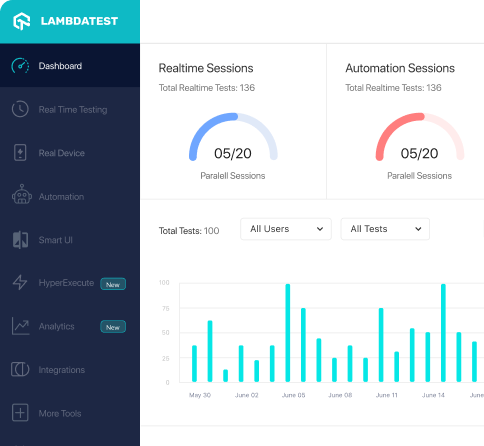How to use ObjectToStringConverter class of io.beanmother.core.converter.std package
Best Beanmother code snippet using io.beanmother.core.converter.std.ObjectToStringConverter
Source: StandardConverterModule.java
...6public class StandardConverterModule implements ConverterModule {7 private static final Set<Converter> standardConverters = new HashSet<>();8 static {9 standardConverters.add(new SameClassConverter(Integer.MAX_VALUE));10 standardConverters.add(new ObjectToStringConverter(Integer.MAX_VALUE));11 standardConverters.add(new NumberToNumberConverter());12 standardConverters.add(new StringToNumberConverter());13 standardConverters.add(new StringToDateConverter());14 standardConverters.add(new StringToSQLDateConverter());15 standardConverters.add(new StringToCalendarConverter());16 standardConverters.add(new StringToFileConverter());17 standardConverters.add(new StringToURIConverter());18 standardConverters.add(new StringToURLConverter());19 standardConverters.add(new DateToSQLDateConverter());20 standardConverters.add(new DateToCalendarConverter());21 standardConverters.add(new StringToEnumConverter());22 }23 @Override24 public Set<Converter> getConverters() {...Source: ObjectToStringConverterTest.java
...6import static org.junit.Assert.assertEquals;7import static org.junit.Assert.assertFalse;8import static org.junit.Assert.assertTrue;9/**10 * Test for {@link ObjectToStringConverter}11 */12public class ObjectToStringConverterTest {13 ObjectToStringConverter converter = new ObjectToStringConverter();14 @Test15 public void testCanHandle() {16 assertTrue(converter.canHandle(new Date(), TypeToken.of(String.class)));17 assertTrue(converter.canHandle("test", TypeToken.of(String.class)));18 assertFalse(converter.canHandle(new Date(), TypeToken.of(Date.class)));19 }20 @Test21 public void testConvert() throws ParseException {22 assertEquals("1", converter.convert(1l, TypeToken.of(String.class)));23 assertEquals("test", converter.convert("test", TypeToken.of(String.class)));24 assertEquals("true", converter.convert(true, TypeToken.of(String.class)));25 }26}...Source: ObjectToStringConverter.java
...3import io.beanmother.core.converter.AbstractConverter;4/**5 * Converter used to convert a any Object to a String6 */7public class ObjectToStringConverter extends AbstractConverter {8 /**9 * Create a ObjectToStringConverter.10 */11 public ObjectToStringConverter() {}12 /**13 * Create a ObjectToStringConverter with a priority14 * @param priority the priority15 */16 public ObjectToStringConverter(int priority) {17 super(priority);18 }19 @Override20 public Object convert(Object source, TypeToken<?> targetTypeToken) {21 return String.valueOf(source);22 }23 @Override24 public boolean canHandle(Object source, TypeToken<?> targetTypeToken) {25 return (source != null) && targetTypeToken.isSubtypeOf(String.class);26 }27}...ObjectToStringConverter
Using AI Code Generation
1public class ObjectToStringConverterTest {2 public static void main(String[] args) {3 ObjectToStringConverter objectToStringConverter = new ObjectToStringConverter();4 System.out.println(objectToStringConverter.convert(null));5 System.out.println(objectToStringConverter.convert("Hello World"));6 System.out.println(objectToStringConverter.convert(10));7 System.out.println(objectToStringConverter.convert(10.0));8 System.out.println(objectToStringConverter.convert(new Date()));9 System.out.println(objectToStringConverter.convert(new Timestamp(System.currentTimeMillis())));10 }11}ObjectToStringConverter
Using AI Code Generation
1public class ObjectToStringConverterTest {2 public static void main(String[] args) {3 ObjectToStringConverter objectToStringConverter = new ObjectToStringConverter();4 String test = objectToStringConverter.convert("test");5 System.out.println(test);6 }7}ObjectToStringConverter
Using AI Code Generation
1ObjectToStringConverter objectToStringConverter = new ObjectToStringConverter();2String result = objectToStringConverter.convert(new Object());3System.out.println(result);4ObjectToStringConverter objectToStringConverter = new ObjectToStringConverter();5String result = objectToStringConverter.convert(new Object());6System.out.println(result);ObjectToStringConverter
Using AI Code Generation
1import java.io.*;2import java.util.*;3import io.beanmother.core.converter.std.*;4public class 3 {5 public static void main(String args[]) {6 ObjectToStringConverter obj = new ObjectToStringConverter();7 System.out.println(obj.convert(new Object()));8 }9}10import java.io.*;11import java.util.*;12import io.beanmother.core.converter.std.*;13public class 4 {14 public static void main(String args[]) {15 ObjectToStringConverter obj = new ObjectToStringConverter();16 System.out.println(obj.convert(new Object()));17 }18}19import java.io.*;20import java.util.*;21import io.beanmother.core.converter.std.*;22public class 5 {23 public static void main(String args[]) {24 ObjectToStringConverter obj = new ObjectToStringConverter();25 System.out.println(obj.convert(new Object()));26 }27}28import java.io.*;29import java.util.*;30import io.beanmother.core.converter.std.*;31public class 6 {32 public static void main(String args[]) {33 ObjectToStringConverter obj = new ObjectToStringConverter();34 System.out.println(obj.convert(new Object()));35 }36}37import java.io.*;38import java.util.*;39import io.beanmother.core.converter.std.*;40public class 7 {41 public static void main(String args[]) {42 ObjectToStringConverter obj = new ObjectToStringConverter();43 System.out.println(obj.convert(new Object()));44 }45}46import java.io.*;47import java.util.*;48import io.beanmother.core.converter.std.*;49public class 8 {50 public static void main(String args[]) {51 ObjectToStringConverter obj = new ObjectToStringConverter();52 System.out.println(obj.convert(new Object()));53 }54}ObjectToStringConverter
Using AI Code Generation
1package com.javatpoint; 2import io.beanmother.core.converter.std.ObjectToStringConverter; 3import java.util.Date; 4public class ObjectToStringConverterExample { 5public static void main(String[] args) { 6ObjectToStringConverter converter=new ObjectToStringConverter(); 7Date date=new Date(); 8System.out.println(converter.convert(date)); 9} 10}ObjectToStringConverter
Using AI Code Generation
1import io.beanmother.core.converter.std.ObjectToStringConverter;2import io.beanmother.core.converter.Converter;3import io.beanmother.core.converter.ConverterException;4public class ObjectToStringConverterExample {5 public static void main(String[] args) {6 Converter converter = new ObjectToStringConverter();7 String str = "Hello";8 String result = converter.convert(str, String.class);9 System.out.println(result);10 Integer integer = 100;11 String result1 = converter.convert(integer, String.class);12 System.out.println(result1);13 Boolean bool = true;14 String result2 = converter.convert(bool, String.class);15 System.out.println(result2);16 }17}18import io.beanmother.core.converter.std.ObjectToBooleanConverter;19import io.beanmother.core.converter.Converter;20import io.beanmother.core.converter.ConverterException;21public class ObjectToBooleanConverterExample {22 public static void main(String[] args) {23 Converter converter = new ObjectToBooleanConverter();24 String str = "Hello";25 boolean result = converter.convert(str, boolean.class);26 System.out.println(result);27 Integer integer = 100;28 boolean result1 = converter.convert(integer, boolean.class);29 System.out.println(result1);30 Boolean bool = true;31 boolean result2 = converter.convert(bool, boolean.class);32 System.out.println(result2);33 }34}ObjectToStringConverter
Using AI Code Generation
1package com.java2novice.beans;2import io.beanmother.core.converter.std.ObjectToStringConverter;3import java.util.Date;4public class MyObjectToStringConverter {5public static void main(String a[]){6ObjectToStringConverter obj = new ObjectToStringConverter();7Date d = new Date();8String str = obj.convert(d);9System.out.println(str);10}11}ObjectToStringConverter
Using AI Code Generation
1 String result1 = converter.convert(integer, String.class);2 System.out.println(result1);3 Boolean bool = true;4 String result2 = converter.convert(bool, String.class);5 System.out.println(result2);6 }7}8import io.beanmother.core.converter.std.ObjectToBooleanConverter;9import io.beanmother.core.converter.Converter;10import io.beanmother.core.converter.ConverterException;11public class ObjectToBooleanConverterExample {12 public static void main(String[] args) {13 Converter converter = new ObjectToBooleanConverter();14 String str = "Hello";15 boolean result = converter.convert(str, boolean.class);16 System.out.println(result);17 Integer integer = 100;18 boolean result1 = converter.convert(integer, boolean.class);19 System.out.println(result1);20 Boolean bool = true;21 boolean result2 = converter.convert(bool, boolean.class);22 System.out.println(result2);23 }24}Blogs
Check out the latest blogs from LambdaTest on this topic:
I routinely come across test strategy documents when working with customers. They are lengthy—100 pages or more—and packed with monotonous text that is routinely reused from one project to another. Yawn once more— the test halt and resume circumstances, the defect management procedure, entrance and exit criteria, unnecessary generic risks, and in fact, one often-used model replicates the requirements of textbook testing, from stress to systems integration.
Sometimes, in our test code, we need to handle actions that apparently could not be done automatically. For example, some mouse actions such as context click, double click, drag and drop, mouse movements, and some special key down and key up actions. These specific actions could be crucial depending on the project context.
Many theoretical descriptions explain the role of the Scrum Master as a vital member of the Scrum team. However, these descriptions do not provide an honest answer to the fundamental question: “What are the day-to-day activities of a Scrum Master?”
In today’s tech world, where speed is the key to modern software development, we should aim to get quick feedback on the impact of any change, and that is where CI/CD comes in place.
When I started writing tests with Cypress, I was always going to use the user interface to interact and change the application’s state when running tests.
Automation Testing Tutorials
Learn to execute automation testing from scratch with LambdaTest Learning Hub. Right from setting up the prerequisites to run your first automation test, to following best practices and diving deeper into advanced test scenarios. LambdaTest Learning Hubs compile a list of step-by-step guides to help you be proficient with different test automation frameworks i.e. Selenium, Cypress, TestNG etc.
LambdaTest Learning Hubs:
- JUnit Tutorial
- TestNG Tutorial
- Webdriver Tutorial
- WebDriverIO Tutorial
- Protractor Tutorial
- Selenium 4 Tutorial
- Jenkins Tutorial
- NUnit Tutorial
- Jest Tutorial
- Playwright Tutorial
- Cypress Tutorial
- PyTest Tutorial
YouTube
You could also refer to video tutorials over LambdaTest YouTube channel to get step by step demonstration from industry experts.
Most used methods in ObjectToStringConverter
Try LambdaTest Now !!
Get 100 minutes of automation test minutes FREE!!



